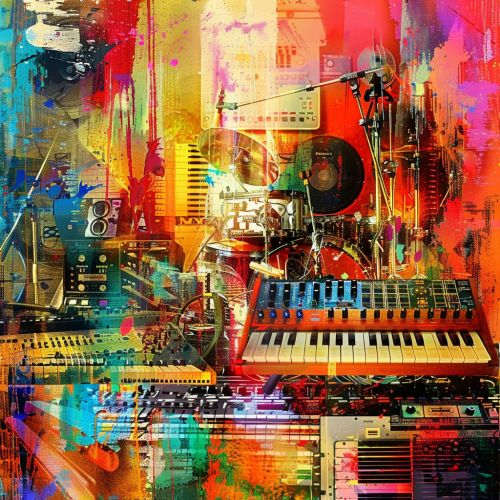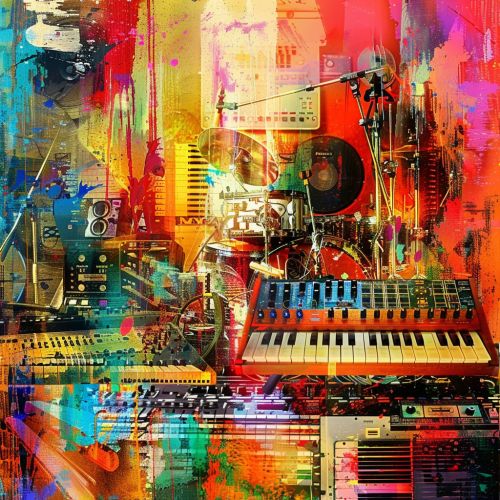Experimental Hip-Hop: Difference between revisions
(Created page with "== Introduction == Experimental hip-hop is a subgenre of hip-hop music that pushes the boundaries of traditional hip-hop by incorporating unconventional sounds, structures, and themes. This genre often blends elements from various musical styles, including electronic, jazz, rock, and avant-garde, to create innovative and unique soundscapes. Experimental hip-hop artists frequently challenge the norms of mainstream hip-hop, exploring complex lyrical themes and employing un...") |
No edit summary |
||
| Line 22: | Line 22: | ||
One of the defining features of experimental hip-hop is its fusion of genres. Artists frequently blend elements from disparate musical styles, creating a hybrid sound that defies easy categorization. This can include the incorporation of [[jazz]], [[rock]], [[classical music]], and [[world music]] influences, resulting in a rich and diverse sonic palette. The genre's openness to experimentation allows for constant evolution and innovation. | One of the defining features of experimental hip-hop is its fusion of genres. Artists frequently blend elements from disparate musical styles, creating a hybrid sound that defies easy categorization. This can include the incorporation of [[jazz]], [[rock]], [[classical music]], and [[world music]] influences, resulting in a rich and diverse sonic palette. The genre's openness to experimentation allows for constant evolution and innovation. | ||
[[Image:Detail-97063.jpg|thumb|center|An abstract representation of experimental hip-hop music, featuring a collage of musical instruments and electronic equipment in a vibrant, colorful setting.|class=only_on_mobile]] | |||
[[Image:Detail-97064.jpg|thumb|center|An abstract representation of experimental hip-hop music, featuring a collage of musical instruments and electronic equipment in a vibrant, colorful setting.|class=only_on_desktop]] | |||
== Notable Artists and Albums == | == Notable Artists and Albums == | ||
Latest revision as of 00:14, 19 July 2024
Introduction
Experimental hip-hop is a subgenre of hip-hop music that pushes the boundaries of traditional hip-hop by incorporating unconventional sounds, structures, and themes. This genre often blends elements from various musical styles, including electronic, jazz, rock, and avant-garde, to create innovative and unique soundscapes. Experimental hip-hop artists frequently challenge the norms of mainstream hip-hop, exploring complex lyrical themes and employing unorthodox production techniques.
Historical Context
Early Influences
The roots of experimental hip-hop can be traced back to the late 1980s and early 1990s, a period marked by significant innovation within the broader hip-hop genre. Pioneering groups such as Public Enemy and De La Soul began to experiment with diverse sounds and lyrical content. Public Enemy's use of dense, layered production and politically charged lyrics set a precedent for future experimentation. Similarly, De La Soul's eclectic sampling and playful, abstract lyrics on their debut album, "3 Feet High and Rising," challenged the conventions of hip-hop at the time.
The Rise of Alternative Hip-Hop
The 1990s saw the emergence of alternative hip-hop, a movement that laid the groundwork for experimental hip-hop. Artists like A Tribe Called Quest, The Pharcyde, and OutKast incorporated jazz, funk, and soul influences into their music, creating a more diverse and sonically rich landscape. This period also saw the rise of independent labels such as Rawkus Records and Stones Throw Records, which provided a platform for artists to explore more experimental sounds without the constraints of major label expectations.
The Influence of Electronic Music
The late 1990s and early 2000s witnessed a significant crossover between hip-hop and electronic music. Producers like DJ Shadow and J Dilla began to incorporate elements of trip-hop, IDM, and ambient music into their beats. DJ Shadow's groundbreaking album "Endtroducing....." (1996) is often cited as a seminal work in the experimental hip-hop genre, characterized by its extensive use of sampling and atmospheric production. J Dilla's "Donuts" (2006) further pushed the boundaries with its fragmented, loop-based compositions.
Key Characteristics
Production Techniques
Experimental hip-hop is distinguished by its innovative production techniques. Producers often employ unconventional sampling methods, drawing from a wide array of sources, including obscure records, field recordings, and found sounds. The use of glitch, noise, and drone elements is also common, creating a more textured and layered sonic experience. Additionally, experimental hip-hop frequently features irregular time signatures, atypical song structures, and abrupt transitions, challenging the listener's expectations.
Lyrical Themes
Lyrically, experimental hip-hop often delves into abstract, introspective, and avant-garde themes. Artists may explore topics such as existentialism, social and political issues, and personal struggles, often employing a stream-of-consciousness or surrealistic approach. The use of complex wordplay, metaphors, and unconventional rhyme schemes is prevalent, further distinguishing the genre from mainstream hip-hop.
Fusion of Genres
One of the defining features of experimental hip-hop is its fusion of genres. Artists frequently blend elements from disparate musical styles, creating a hybrid sound that defies easy categorization. This can include the incorporation of jazz, rock, classical music, and world music influences, resulting in a rich and diverse sonic palette. The genre's openness to experimentation allows for constant evolution and innovation.


Notable Artists and Albums
Pioneers
Several artists are widely regarded as pioneers of experimental hip-hop. MF DOOM, with his intricate wordplay and unconventional production, has been a significant influence on the genre. His album "Madvillainy" (2004), a collaboration with producer Madlib, is considered a landmark in experimental hip-hop. El-P, both as a solo artist and as a member of Company Flow and Run the Jewels, has consistently pushed the boundaries of hip-hop with his abrasive, industrial-influenced production and politically charged lyrics.
Contemporary Innovators
In recent years, a new generation of artists has continued to expand the experimental hip-hop landscape. Death Grips, known for their aggressive, genre-defying sound, have garnered a dedicated following with albums like "The Money Store" (2012) and "No Love Deep Web" (2012). Flying Lotus, a producer and musician, has blended hip-hop with electronic, jazz, and psychedelic influences on albums such as "Cosmogramma" (2010) and "You're Dead!" (2014). JPEGMAFIA and Armand Hammer are other notable contemporary artists who have gained recognition for their innovative approaches to hip-hop.
Cultural Impact
Influence on Mainstream Hip-Hop
While experimental hip-hop remains a niche genre, its influence on mainstream hip-hop is undeniable. Many mainstream artists have incorporated experimental elements into their music, blurring the lines between genres. For example, Kanye West's "Yeezus" (2013) features industrial and electronic influences, while Kendrick Lamar's "To Pimp a Butterfly" (2015) incorporates jazz and funk elements. These albums have brought experimental sounds to a wider audience, demonstrating the genre's impact on contemporary hip-hop.
Intersection with Other Art Forms
Experimental hip-hop often intersects with other art forms, including visual art, film, and performance art. Many artists in the genre collaborate with visual artists to create immersive live performances and innovative music videos. For example, Flying Lotus's live shows often feature elaborate visual projections, while Death Grips have produced a series of provocative and visually striking music videos. This interdisciplinary approach further distinguishes experimental hip-hop from more traditional forms of the genre.
Challenges and Criticisms
Accessibility
One of the primary challenges facing experimental hip-hop is its accessibility. The genre's unconventional sounds and abstract themes can be difficult for some listeners to engage with, limiting its mainstream appeal. However, this very complexity is also what attracts a dedicated and passionate fanbase, who appreciate the genre's willingness to push boundaries and challenge norms.
Commercial Viability
The commercial viability of experimental hip-hop is another significant challenge. Many artists in the genre operate on independent labels or self-release their music, often facing financial constraints and limited promotional resources. Despite these challenges, the rise of digital platforms and social media has provided new opportunities for experimental hip-hop artists to reach audiences and gain recognition.
Future Directions
Technological Advancements
As technology continues to evolve, so too does the potential for innovation within experimental hip-hop. Advances in music production software and hardware have made it easier for artists to experiment with new sounds and techniques. Virtual reality and augmented reality technologies also hold promise for creating immersive, multi-sensory experiences that could further push the boundaries of the genre.
Global Influence
The globalization of music has led to increased cross-cultural exchange, and experimental hip-hop is no exception. Artists from around the world are incorporating their unique cultural influences into the genre, resulting in a more diverse and globally representative sound. This trend is likely to continue, further enriching the experimental hip-hop landscape.
Conclusion
Experimental hip-hop is a dynamic and ever-evolving genre that challenges the conventions of traditional hip-hop. Through innovative production techniques, complex lyrical themes, and a willingness to blend diverse musical influences, artists within the genre continue to push the boundaries of what hip-hop can be. While it may face challenges in terms of accessibility and commercial viability, the genre's impact on both mainstream hip-hop and broader cultural landscapes is undeniable. As technology and global influences continue to shape the music industry, experimental hip-hop is poised to remain at the forefront of musical innovation.
